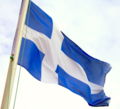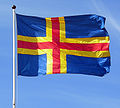- Nordic Cross flag
-
The Nordic Cross Flag, Nordic Cross, or Scandinavian Cross is a pattern of flags usually associated with the flags of the Scandinavian countries of which it originated. All of the Nordic countries except Greenland have adopted such flags. The cross design, which represents Christianity,[1][2][3] is depicted extending to the edges of the flag with the vertical part of the cross shifted to the hoist side, rather than centred on the flag. All Scandinavian flags may be flown as gonfalons as well.
The first flag with the design was the Danish Dannebrog; thereafter, Sweden, Norway, Finland, Iceland, and some of their subdivisions used this as inspiration for their own flags. The Norwegian flag was the first Nordic cross flag with three colours. Though the flags share this pattern, they have individual histories and symbolism.
Some of the flags in this list do not have official status. Also, note that flag proportions may vary between the different flags and sometimes even between different versions of the same flag.
Flags of the Nordic countries
Note that most of these flags are historical or have not been officially adopted and their use remains limited.
-
Reconstruction of the flag of the Kalmar Union; Denmark, Norway and Sweden (1397–1523) -
Flag of the Nordisk Flaggselskap or Nordic Flag Society [1]
Denmark
-
Unofficial flag of Bornholm (commonly used) -
Another proposal for flag of Jutland, dating from 1972 (not in use) -
Proposed flag of Vendsyssel
Finland
-
State flag of Finland. -
War flag and naval ensign of Finland. -
Flag of the President of Finland, with the Cross of Liberty in the canton. -
Flag used by Finnish yacht clubs. Club insignia goes in the canton. -
Flag representing the Swedish-speaking minority in Finland.
Iceland
-
State flag of Iceland -
Flag of the President of Iceland -
Former unofficial flag of Iceland (ca. 1900)
Norway
-
Former flag of Norway (1814-1821). -
The common naval ensign and war flag of Sweden and Norway from 1815 to 1844. -
Merchant flag of Norway 1844-1898 with the union badge representing the union with Sweden. -
Flag of Norwegian fascist party Nasjonal Samling 1933-1945.
Sweden
-
Royal standard of Sweden with the Greater coat of arms, used by the King of Sweden -
Royal standard of Sweden with the lesser coat of arms (the royal house using the greater coat of arms) -
Flag of Sweden 1844-1905 representing the union with Norway -
Unofficial flag of Småland (no actual use recorded) -
Unofficial flag of Östergötland -
Unofficial flag of Västergötland[5] -
Unofficial flag of Härjedalen -
Unofficial flag of Gotland -
Unofficial flag of Öland -
Flag of the Catholic Cathedral of Stockholm -
Unofficial flag of the Finnish speaking minority in Sweden
Autonomous regions
-
Flag of the Faroe Islands, an autonomous region of Denmark -
Flag of Åland, an autonomous region of Finland -
Proposal for Flag of Greenland, designed in 1984 by Sven Tito Achen. Rejected in favour of non-Nordic-Cross flag.
Flags of Germany
Nordic flags in Germany were historically used to allude to the nation's Norse heritage and Nordic origins. Nordic flag designs very similar to Denmark's, Sweden's, and Norway's national flags were proposed as Germany's national flags in both 1919 and 1948, after World War I and World War II, respectively. Today, the Nordic cross is a feature in some city and district flags or coats of arms.
-
Former Kaiserliche Marine War Ensign of Imperial Germany (1903-1919) -
Former War Ensign of Nazi Germany (1938-1945), now forbidden in Germany -
Flag of the former Saar protectorate, Germany -
Proposed National flag of Germany, circa 1919.
Flags of the United Kingdom
Many locations in Scotland and England were colonized by Norwegian and Danish settlers and viking raiders during the 9th, 10th, and 11th centuries. Several locales, particularly in the Scottish islands, have flags or have had flag proposals based on the Nordic cross as a recognition of this Scandinavian heritage.
Scotland
Former and unofficial flags (Scotland)
-
Purported flag of the Crown Dependency of Forvik, a self-declared "micronation" in the Shetland islands. -
Unofficial flag of the island of South Uist, in the Outer Hebrides. -
Unofficial flag of the island of Barra, in the Outer Hebrides.
Flag proposals and unofficial flags (England)
-
Flag proposal for Northern England. -
Former proposal for a flag of Yorkshire
Flags of the Baltic states
Many territories around the Baltic Sea have begun using Nordic cross flags. Sometimes this is done to bolster the locality's association with the Scandinavian states (and, as with the proposed flags of Latvia and Estonia, to assert a Baltic identity over a long-standing affiliation with the Russian sphere of influence.)
-
Proposed new flag of
Estonia -
Flag of Setomaa, Estonia and Pskov Oblast (Russia)
Flags of ethnic or linguistic groups
-
Unofficial flag of the Votes -
Former flag of East Karelia -
Unofficial flag of Frisia
Flags elsewhere that feature the Nordic Cross or similar design
-
Flag of Bayamón, Puerto Rico -
Flag of Little Rock, Arkansas, the United States -
Flag of Stavropol Krai, Russia -
Naval ensign of Tonga -
Flag of Volyns'ka Oblast', Ukraine -
The "Vinland flag", not actually used when North America was known as Vinland -
Campaign Flag of Puerto Rican Independence Party -
Flag of Bleimor Breton Scouting organization. -
Alternative flag of Tudela, Navarre -
Flag of Wilmington, Delaware
Flags of Brazilian municipalities
-
Flag of the City of São Paulo, SP -
Flag of Alegre, ES -
Flag of Areias, SP -
Flag of Borborema, SP -
Flag of Carmo do Paranaíba, MG -
Flag of Chapadinha, MA -
Flag of Colorado, RS -
Flag of Domingos Martins, ES -
Flag of Guaíra, SP -
Flag of Itu, SP -
Flag of Jacupiranga, SP -
Flag of Lagoa Formosa, MG -
Flag of Nova Era, MG -
Flag of Pirapora do Bom Jesus, SP -
Flag of Santo Antônio do Pinhal, SP -
Flag of Santo Cristo, RS -
Flag of Vinhedo, SP
Flags of Football Clubs
Flag of Santos F.C., Brazil.
Non-Nordic Cross flags of areas associated with the Nordic countries
-
Flag of Sápmi and the Sami people
Although different, the offset of the circles and the lines are reminiscent of the Nordic cross flags.
Image gallery
See also
- Flags of Central America
- Flag of Gran Colombia
- Pan-African colours
- Pan-Arab colours
- Pan-Slavic colours
- Southern Cross Flag
- Tricolour
References
- ^ Jeroen Temperman. State Religion Relationships and Human Rights Law: Towards a Right to Religiously Neutral Governance. Martinus Nijhoff Publishers. p. 88. http://books.google.com/books?id=Khag6tbsIn4C&pg=PA88&dq=flag+of+sweden+christian&ei=S3tGTZrYAcqr8AbOqcWgDg&sa=X&oi=book_result&ct=result&resnum=4&ved=0CFAQ6AEwAzgK#v=onepage&q=flag%20of%20sweden%20christian&f=false. Retrieved 2007-12-31. "Many predominantly Christian states show a cross, symbolising Christainity, on their national flag. The so-called Scandinavian crosses or Nordic crosses on the flags of the Nordic countries–Denmark, Finland, Iceland, Norway and Sweden–also represent Christianity."
- ^ Carol A. Foley. The Australian Flag: Colonial Relic or Contemporary Icon. William Gaunt & Sons. http://books.google.com/books?id=WV7ag4EpHF8C&pg=PA10&dq=sweden+flag+cross+christian&ei=ZX5GTcO3MIH58Abcq6jqAQ&sa=X&oi=book_result&ct=result&resnum=8&ved=0CGkQ6AEwBw#v=onepage&q=sweden%20flag%20cross%20christian&f=false. Retrieved 2007-12-31. "The Christian cross, for instance, is one of the oldest and most widely used symbols in the world, and many European countries, such as the United Kingdom, Norway, Sweden, Finland, Denmark, Iceland, Greece and Switzerland, adopted and currently retain the Christian cross on their national flags."
- ^ Andrew Evans. Iceland. Bradt. http://books.google.com/books?id=9_GfdBAASUQC&pg=PA27&dq=iceland+flag+christianity&ei=3YNGTbOfNML98AaumrzkDQ&sa=X&oi=book_result&ct=result&resnum=1&ved=0CEQQ6AEwAA#v=onepage&q=iceland%20flag%20christianity&f=false. Retrieved 2007-12-31. "Legend states that a red cloth with the white cross simply fell from the sky in the middle of the 13-century Battle of Valdemar, after which the Danes were victorious. As a badge of divine right, Denmark flew its cross in the other Scandinavian countries it ruled and as each nation gained independence, they incorporated the Christian symbol."
- ^ Kunstavisen
- ^ http://www.handelskammaren.net/sv/Omoss/Historik/Vastsvenska-flaggan/
- ^ In 1844, German nationalists in the two duchies of Holstein and Schleswig created a blue-white-red tricolour as a symbol for independence which began to see widespread use. In 1845, Denmark responded by outlawing all other flags than the Danish one shown here. This ban was enforced as long as Denmark controlled the two duchies (Holstein and Lauenburg: effectively until 1863, in Schleswig effectively until early 1864.) Use of the Danish flag was in turn outlawed by the secessionist administration that claimed both provinces 1848-1851.
External links
Categories:- Lists of flags
- Scandinavia
- Nordic countries
- Cross symbols
- Christian symbols
- Nordic Cross flags
-
Wikimedia Foundation. 2010.
































































































































